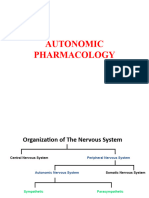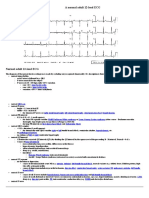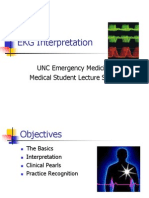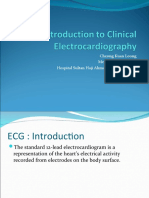0 ratings0% found this document useful (0 votes)
11 viewsInternal Medicine
Internal Medicine
Uploaded by
Abdilahi AskariCopyright:
© All Rights Reserved
Available Formats
Download as PPTX, PDF, TXT or read online from Scribd
Internal Medicine
Internal Medicine
Uploaded by
Abdilahi Askari0 ratings0% found this document useful (0 votes)
11 views43 pagesCopyright
© © All Rights Reserved
Available Formats
PPTX, PDF, TXT or read online from Scribd
Share this document
Did you find this document useful?
Is this content inappropriate?
Copyright:
© All Rights Reserved
Available Formats
Download as PPTX, PDF, TXT or read online from Scribd
Download as pptx, pdf, or txt
0 ratings0% found this document useful (0 votes)
11 views43 pagesInternal Medicine
Internal Medicine
Uploaded by
Abdilahi AskariCopyright:
© All Rights Reserved
Available Formats
Download as PPTX, PDF, TXT or read online from Scribd
Download as pptx, pdf, or txt
You are on page 1of 43
INTERNAL MEDICINE
CARDIOLOGY
ECG
Prepared by : Dr. Abdullahi Muktar Abdikadir
GROSS ANATOMY
ELECTROCARDIOGRAM
An ECG provides an assessment of the electrical
activity of the heart. The heart rate, rhythm, axis,
intervals, ischemia, and chamber enlargement can
be evaluated
ECG LEADS
1: Chest leads
2: Limb leads
LIMB LEADS
NORMAL ECG
Rate
Normal adult heart rate (HR) is 60–100 beats/min
(bpm). HR <60 bpm is bradycardia.
Heart rate >100 bpm is tachycardia.
Common causes of sinus bradycardia are
1: physical fitness, sick sinus syndrome, drugs,
vasovagal attacks, acute myocardial infarction (MI), and
↑ intracranial pressure.
Common causes of sinus tachycardia are anxiety,
anemia, pain, fever, sepsis, congestive heart failure
(CHF), pulmonary embolism, hypovolemia,
thyrotoxicosis,
carbon dioxide (CO2) retention, and sympathomimetics.
Rhythm
Sinus rhythm: Normal rhythm that originates from
the sinus node. It is characterized by a P wave
(upright in leads II, III, and aVF; inverted in lead
aVR) preceding every QRS complex and a QRS
complex following every P wave.
Sinus arrhythmia is a sinus rhythm originating
from the sinoatrial (SA) node with cyclical beat-to-
beat variation (>120 milliseconds [msec]) in the P-
P interval and a constant P-R interval, which
results in an irregular ventricular rate. It is
common in young adults and is considered a
normal variant.
Axis The QRS axis represents the direction in which the mean QRS
current flows. It can be determined by examining the QRS in leads I, II,
and aVF
Intervals
PR interval: Normally 120 to 200 msec (3–5 small
boxes). Prolonged = delayed atrioventricular (AV)
conduction (eg, first-degree heart block).
Short = fast AV conduction down accessory
pathway (eg, Wolff-Parkinson-White [WPW]
syndrome).
QRS interval: Normally <120 msec. A normal Q
wave is <40 msec wide and <2 mm deep.
Ventricular conduction defects can cause a widened
QRS complex (>120 msec)
Left bundle-branch block (LBBB): Deep S wave and
no R wave in V1 (“W” shaped); wide, tall and
broad, or notched (“M”-shaped) R waves in I, V5,
and V6 . A new LBBB is pathologic, and it may be
suggestive of acute MI. However, this is not
diagnostic in isolation. Rather, the Modified
Sgarbossa Criteria (see key fact) should be used for
the ECG diagnosis of acute MI in this situation
(higher sensitivity and specificity).
KEY FACT
Smith-Modified Sgarbossa Criteria are used to
diagnose MI in the presence of LBBB should be
suspected in a patient with LBBB and the following
ECG findings:
Concordant ST elevation (STE) ≥1 mm in ≥1 lead
Concordant ST depression ≥1 mm in ≥1 lead of V1–
V3
Excessive discordant STE in ≥1 lead with ≥1 mm
STE, where excessive discordance is defined as STE
to the maximum QRS amplitude ratio ≥25%
Right bundle-branch block (RBBB): RSR′ complex
(“rabbit ears;” “M”-shaped); qR or R morphology
with a wide R wave in V1; QRS pattern with a wide
S wave in I, V5, and V6
QT interval: Normally QTc (the QT interval
corrected for extremes in heart rate) is 380 to 440
msec (QTc = QT/√RR). QTc may be prolonged (QTc
>440 msec) due to acquired causes, including
electrolyte derangements (↓ K+, ↓ Ca2+, ↓ Mg2+)
and medications (macrolides, fluroquinolones,
opioids, ondansetron, Classes Ia [quinidine,
procainamide] and III [sotalol, amiodarone]
antiarrhythmic drugs). Congenital causes include
long QT syndrome (LQTS), an underdiagnosed
disorder that predisposes to ventricular
tachyarrhythmias (eg, torsade de pointes) and
sudden cardiac death (SCD, see later).
Within hours, peaked T-waves and ST-segment
changes (either depression or elevation). Within
24 hours, T-wave inversion and ST-segment
resolution. Within a few days, pathologic Q waves
(>40 msec or more than one-third of the QRS
amplitude). Q waves usually persist, but may
resolve in 10% of patients. Because of this,
Q waves signify either acute or prior ischemic
events. Non–Q-wave infarcts (also known as
subendocardial infarcts) have ST and T changes
without Q waves. In a normal ECG, R waves
increase in size compared to the S wave between
leads V1 and V5. Poor R-wave progression refers to
abnormalities in this pattern (eg, reversed
progression [R in V2 > V3], transition point beyond
V4, R in V3 <3 mm) and can be a sign of new or
prior anterior infarction, although it is not specific.
Chamber Enlargement
Atrial enlargement: Right atrial abnormality (P
pulmonale): Generally, the right atrium (RA)
depolarizes before the left. Right atrial
enlargement (due to pulmonary hypertension [eg,
chronic obstructive, pulmonary disease, tetralogy
of Fallot, tricuspid atresia]) causes slowed
conduction; therefore peak right atrial
depolarization coincides with left. This results in
increased P-wave amplitude (>2.5 mm in lead II).
Left atrial abnormality (P mitrale): Left atrial
enlargement causes prolonged left atrial (LA)
depolarization, increased P-wave duration (>120
msec in lead II), and sometimes a V-shape occurs in
P wave (also in lead II) .
Also, the P wave in lead V1 may have a large
negative deflection (>1 small square wide and 1
small square deep in a standard tracing).
Commonly seen in isolation in mitral stenosis or
associated with LV hypertrophy
Amplitude of S in V1 + R in V5 or V6 is >35 mm.
Alternative criteria: The amplitude of R in aVL + S in
V3 is >28 mm in men or >20 mm in women.
Usually associated with ST depression and T-wave
changes.
Causes include hypertension (most common),
aortic stenosis/regurgitation, mitral regurgitation,
coarctation of the aorta, and hypertrophic
cardiomyopathy.
Right ventricular hypertrophy (RVH):
Right-axis deviation and an R wave in V1 >7 mm.
Causes
pulmonary hypertension, pulmonary embolism,
chronic lung disease (cor pulmonale), mitral
stenosis, and congenital heart disease (eg, tetralogy
of Fallot, pulmonary stenosis).
KEY FACT
Axis deviation can be a sign of ventricular enlargement
MNEMONIC
“D ARMS PITS” Diastolic Murmurs Aortic
Regurgitation Mitral Stenosis Pulmonary
Insufficiency Tricuspid Stenosis
END OF THE LECTURE
You might also like
- Medicine PulDocument86 pagesMedicine Pulabhijeets3011No ratings yet
- Roman Punjabi English DictionaryDocument939 pagesRoman Punjabi English DictionaryHeera SinghNo ratings yet
- Gurmukhi - Harkesh Singh Kehal - Alop Ho Reha Punjabi VirsaDocument185 pagesGurmukhi - Harkesh Singh Kehal - Alop Ho Reha Punjabi Virsanavlife8100% (1)
- Answer Diagnosis: 1. RhythmDocument2 pagesAnswer Diagnosis: 1. RhythmSuggula Vamsi KrishnaNo ratings yet
- Basic of EcgDocument82 pagesBasic of Ecgpopescuioana1No ratings yet
- Jesse Felts PGY2, Not A CardiologistDocument43 pagesJesse Felts PGY2, Not A Cardiologistイオン天国No ratings yet
- Paediatric RadiographyDocument102 pagesPaediatric RadiographyMunish Dogra100% (3)
- The Massachusetts Eye Illustrated Manual of Ophthalmology 4th EditionDocument1,212 pagesThe Massachusetts Eye Illustrated Manual of Ophthalmology 4th Editionsare7786% (7)
- 108 Sri Krishna NamavaliDocument4 pages108 Sri Krishna NamavaliBasker YogacharyaNo ratings yet
- Cardiology WorkBookDocument102 pagesCardiology WorkBookCastleKG100% (1)
- Gurmat Prabhakar PunjabiDocument689 pagesGurmat Prabhakar PunjabiSukhpreet SinghNo ratings yet
- Gurmat Gyan Part 1Document168 pagesGurmat Gyan Part 1sandeep singh0% (1)
- Bani of Bhagats Part 1 by GS ChauhanDocument440 pagesBani of Bhagats Part 1 by GS ChauhanPuran Singh LabanaNo ratings yet
- C PharmacologyDocument21 pagesC PharmacologyadjaniyuNo ratings yet
- AAA Type 2 Diabetes Annals of Internal MedicineDocument19 pagesAAA Type 2 Diabetes Annals of Internal MedicineCelebfan BoyNo ratings yet
- Kent Repertory Urdu-Eng.Document98 pagesKent Repertory Urdu-Eng.RiazMuhammad100% (1)
- Review of Autonomic PharmacologyDocument42 pagesReview of Autonomic PharmacologyselormniiqNo ratings yet
- RSV Vaccine Journal ClubDocument18 pagesRSV Vaccine Journal Clubapi-719803017100% (1)
- Chronic Kidney FailureDocument89 pagesChronic Kidney FailureMateen Shukri100% (1)
- Arrhythmias: Domina Petric, MDDocument22 pagesArrhythmias: Domina Petric, MDMwaba PeterNo ratings yet
- Dr. Alurkur's Book On Cardiology - 2Document85 pagesDr. Alurkur's Book On Cardiology - 2Bhattarai ShrinkhalaNo ratings yet
- Nuri & Anjali GeetDocument381 pagesNuri & Anjali Geetragna a100% (1)
- About The Heart and Blood Vessels Anatomy and Function of The Heart ValvesDocument4 pagesAbout The Heart and Blood Vessels Anatomy and Function of The Heart ValvesdomlhynNo ratings yet
- Hindu Gods Differentiated Reading Comprehension ActivityDocument11 pagesHindu Gods Differentiated Reading Comprehension ActivitybayaNo ratings yet
- W-2-Sevigny-Basic ECG PDFDocument61 pagesW-2-Sevigny-Basic ECG PDFdheaNo ratings yet
- CVS Examination 3rd MBDocument30 pagesCVS Examination 3rd MBsnowlover boyNo ratings yet
- Derm Flashcards - QuizletDocument2 pagesDerm Flashcards - QuizletCERTIFIED TROLLNo ratings yet
- ECG Interpretation TheoryDocument4 pagesECG Interpretation TheorySteph PiperNo ratings yet
- Ecg For InternsDocument25 pagesEcg For InternszeshooNo ratings yet
- Life of Lord Ram (Final)Document4 pagesLife of Lord Ram (Final)Piyush Omprakash AgarwalNo ratings yet
- Aayurved Siddhant Rahasya-3Document54 pagesAayurved Siddhant Rahasya-3manushioshoNo ratings yet
- Human Anatomy in Atharva VedaDocument10 pagesHuman Anatomy in Atharva VedaAnuradha VenugopalNo ratings yet
- The Panjábí DictionaryDocument1,247 pagesThe Panjábí DictionaryhiteshNo ratings yet
- Gods False Gods and Untouchables (1) - CompressedDocument385 pagesGods False Gods and Untouchables (1) - Compressedchandra kanth lakkaNo ratings yet
- Here Is A List of Commonly Tested Facts in Hte MRCP Part 1 ExamDocument7 pagesHere Is A List of Commonly Tested Facts in Hte MRCP Part 1 Examasallam100% (1)
- Jainism in Medieval IndiaDocument50 pagesJainism in Medieval IndiaBharat Jain100% (1)
- Yuvan Pidika Acne EtiologyDocument8 pagesYuvan Pidika Acne EtiologyMSKCNo ratings yet
- A Normal Adult 12Document8 pagesA Normal Adult 12el adikkzNo ratings yet
- ECG NormalDocument9 pagesECG NormalDya AndryanNo ratings yet
- Arrhthmias 1Document50 pagesArrhthmias 1alkingzarosNo ratings yet
- A Normal Adult 12-Lead ECG: Sinus Bradycardia Sinus Tachycardia QRS AxisDocument4 pagesA Normal Adult 12-Lead ECG: Sinus Bradycardia Sinus Tachycardia QRS AxisSharan SandhuNo ratings yet
- Normal ECGDocument2 pagesNormal ECGGeneon100% (1)
- EKG Interpretation: UNC Emergency Medicine Medical Student Lecture SeriesDocument58 pagesEKG Interpretation: UNC Emergency Medicine Medical Student Lecture SeriesNathalia ValdesNo ratings yet
- ECG and ArrhythmiasDocument25 pagesECG and ArrhythmiasRashed ShatnawiNo ratings yet
- Cheong Kuan Loong Medical Department Hospital Sultan Haji Ahmad Shah, Temerloh 12/5/10Document99 pagesCheong Kuan Loong Medical Department Hospital Sultan Haji Ahmad Shah, Temerloh 12/5/10Haq10No ratings yet
- ECG NotesDocument7 pagesECG NotesShams NabeelNo ratings yet
- P Wave With A Broad ( 0.04 Sec or 1 Small Square) and Deeply Negative ( 1 MM) Terminal Part in V1 P Wave Duration 0.12 Sec in Leads I and / or IIDocument9 pagesP Wave With A Broad ( 0.04 Sec or 1 Small Square) and Deeply Negative ( 1 MM) Terminal Part in V1 P Wave Duration 0.12 Sec in Leads I and / or IIpisbolsagogulamanNo ratings yet
- Reference Values For Adult EcgDocument19 pagesReference Values For Adult EcgKyra PoggenpoelNo ratings yet
- ECG InterpretationDocument83 pagesECG InterpretationJuana Maria Garcia Espinoza100% (2)
- EcgDocument6 pagesEcgMohamed IbrahimNo ratings yet
- ECG & ArrhythmiasDocument8 pagesECG & ArrhythmiasDr. SobanNo ratings yet
- ECG InterpretationDocument168 pagesECG InterpretationPavi YaskarthiNo ratings yet
- Principles of ECGDocument11 pagesPrinciples of ECGDeinielle Magdangal RomeroNo ratings yet
- ECG Master Class-1Document132 pagesECG Master Class-1Shohag ID Center100% (1)
- Lia TrapaidzeDocument32 pagesLia TrapaidzeShubham TanwarNo ratings yet
- Conduction AbnormalitiesDocument16 pagesConduction Abnormalitiesmerin sunilNo ratings yet
- Workshop ECG in Special Cases Surya BatamDocument50 pagesWorkshop ECG in Special Cases Surya Batamsurya marthiasNo ratings yet
- ECG AbnormalDocument60 pagesECG Abnormalvidishmalaviya300No ratings yet
- Ekg Panum or OsceDocument69 pagesEkg Panum or OsceGladish RindraNo ratings yet
- A Simplified ECG GuideDocument4 pagesA Simplified ECG GuidecherryNo ratings yet
- ECG ExaminationDocument70 pagesECG ExaminationPercy Caceres OlivaresNo ratings yet
- TH TH TH THDocument9 pagesTH TH TH THAlex PengNo ratings yet
- An Isothermal CRISPR - Based Lateral Flow Assay For Detection of Neisseria MeningitidisDocument8 pagesAn Isothermal CRISPR - Based Lateral Flow Assay For Detection of Neisseria Meningitidisd4rkgr455No ratings yet
- Herbal MedsDocument11 pagesHerbal MedsKIM NAMJOON'S PEACHES & CREAMNo ratings yet
- Gestational Diabetes Mellitus (GDM)Document24 pagesGestational Diabetes Mellitus (GDM)asyrafali93No ratings yet
- Christine Schaffner How To Use The Matrix To Address Chronic Health ConditionsDocument9 pagesChristine Schaffner How To Use The Matrix To Address Chronic Health ConditionsPoorni Shivaram100% (1)
- Rife AilDocument68 pagesRife Ailapi-3764182100% (9)
- Oxybutynin Chloride Tablet, USPDocument8 pagesOxybutynin Chloride Tablet, USPsurafelNo ratings yet
- Occupational English Test: Writing Sub-Test: Nursing Time Allowed: Reading Time: 5 Minutes Writing Time: 40 MinutesDocument2 pagesOccupational English Test: Writing Sub-Test: Nursing Time Allowed: Reading Time: 5 Minutes Writing Time: 40 MinutesAnit XingNo ratings yet
- Principles of Hearing Aid AudiologyDocument9 pagesPrinciples of Hearing Aid AudiologyANURAG PANDEYNo ratings yet
- Essay On RomanceDocument7 pagesEssay On Romancehyyaqmaeg100% (2)
- Psych Ward HistoryDocument6 pagesPsych Ward HistoryNestley TiongsonNo ratings yet
- Changes in Different Health Dimension During AdolescenceDocument11 pagesChanges in Different Health Dimension During AdolescenceGia Angela SantillanNo ratings yet
- Case Presentation On Ischemic Cardiomyopathy & Ccf-1-1Document18 pagesCase Presentation On Ischemic Cardiomyopathy & Ccf-1-1Maliha aliNo ratings yet
- Patient Presenting ComplaintDocument13 pagesPatient Presenting ComplaintbalajimuthuNo ratings yet
- Ending The Triple Threat Commitment Plan 2024Document76 pagesEnding The Triple Threat Commitment Plan 2024Kevin SilaNo ratings yet
- PreOperative CareDocument9 pagesPreOperative CareYana Pot100% (2)
- Cardiovascular SystemDocument16 pagesCardiovascular SystemTofik MohammedNo ratings yet
- Mariamawit AsfawDocument59 pagesMariamawit AsfawsaryNo ratings yet
- Daftar Harga DiagnosaDocument9 pagesDaftar Harga DiagnosaIrpan FirmansyahNo ratings yet
- Tamiflu Epar Procedural Steps Taken Scientific Information After Authorisation - enDocument40 pagesTamiflu Epar Procedural Steps Taken Scientific Information After Authorisation - enακηςNo ratings yet
- Sas 9Document2 pagesSas 9Charlene LagradillaNo ratings yet
- ABO-RH IncompatiilityDocument6 pagesABO-RH IncompatiilitymarisonaningatNo ratings yet
- Lincomycin HydrochlorideDocument1 pageLincomycin HydrochlorideDiego TorresNo ratings yet
- Soft Tissue Injury Pathophysiology - EricaDocument33 pagesSoft Tissue Injury Pathophysiology - EricaHen DriNo ratings yet
- Clinical Features of Malaria: Nomika Alli Roll No 179Document33 pagesClinical Features of Malaria: Nomika Alli Roll No 179Sai Mythili MunukutlaNo ratings yet
- Aloe Vera Their Chemicals Composition and Applications-A ReviewDocument7 pagesAloe Vera Their Chemicals Composition and Applications-A Reviewbing mirandaNo ratings yet
- Intracardiac PressuresDocument41 pagesIntracardiac Pressureswaleed315No ratings yet
- Final Corrected DKA AselaDocument32 pagesFinal Corrected DKA AselaabelNo ratings yet
- - - TPN presentation - نسخة-1 (3119)Document24 pages- - TPN presentation - نسخة-1 (3119)Dr mudasir nazirNo ratings yet

























































































